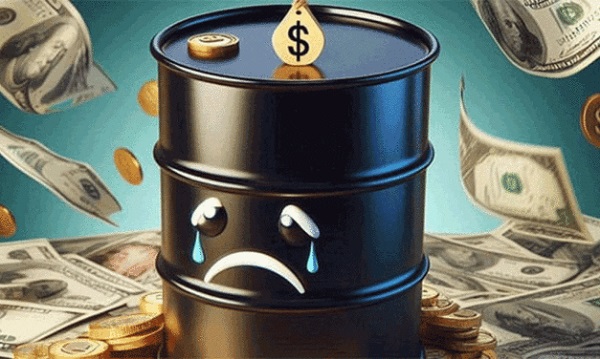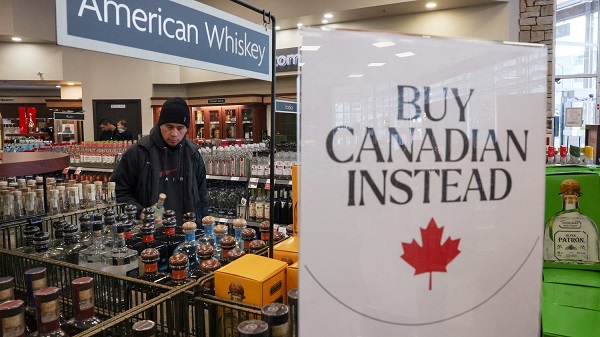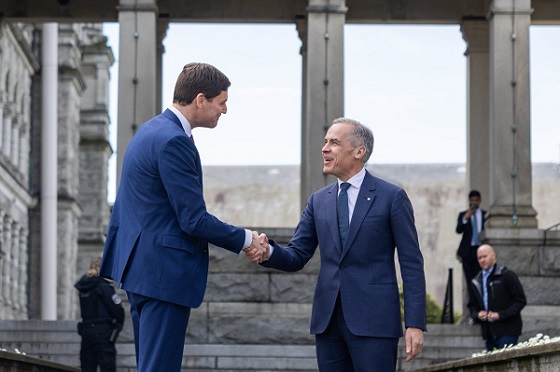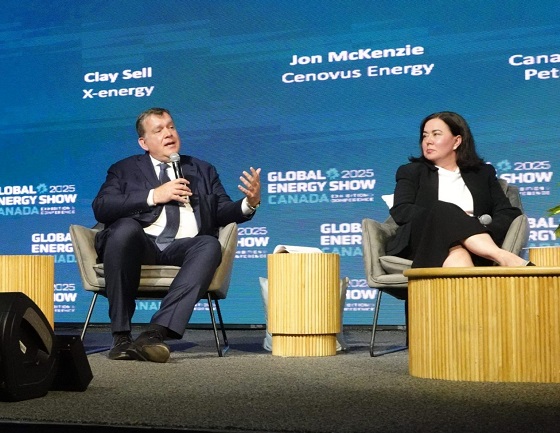Business
Trudeau’s four-day trip to Europe racks up $71,000 food bill

From the Canadian Taxpayers Federation
By Ryan Thorpe
“It would have been cheaper for each member of the prime minister’s delegation to go to the Keg, order a prime rib steak, a Caesar salad, baked garlic shrimp and a bottle of pinot noir for every meal.”
Break out the DVD player and aerate a few bottles of the 2015 Riesling, because Prime Minister Justin Trudeau has an important work trip.
The food bill for Trudeau’s four-day trip to Italy and Switzerland this June cost more than $71,000, including at least $43,000 spent on airplane food alone, according to the records.
That works out to an average meal cost of $145. Add it up and the total food bill averaged more than $1,700 per member of the Canadian delegation.
To put that in context: the average Canadian family of four spends about $1,400 on food per month, according to Canada’s Food Price Report.
“The per person food bill for Trudeau and his entourage on this trip was more than the average Canadian family spends on groceries in a month,” said Franco Terrazzano, CTF Federal Director. “It would have been cheaper for each member of the prime minister’s delegation to go to the Keg, order a prime rib steak, a Caesar salad, baked garlic shrimp and a bottle of pinot noir for every meal.”
The total taxpayer tab for the four-day trip came to nearly $1 million, according to access-to-information records obtained by the Canadian Taxpayers Federation from the Department of National Defence and the Privy Council Office.
The cost of the trip could be even higher, as “some accommodations were covered by Global Affairs Canada,” according to the records.
Trudeau travelled to Apulia, Italy, and Lucerne, Switzerland, between June 13 and 16, 2024, to attend a G7 Summit and a Summit on Peace in Ukraine.
All told, the trip cost Canadian taxpayers at least $918,000, according to the records.
Prior to take-off, government bureaucrats purchased $812 worth of junk food from a grocery store – including Red Bull, pop (Pepsi, Coke, Sprite), chocolate bars (Kit Kats, Twix’s, Reece’s Pieces) and candy (Swedish Berries, Fuzzy Peaches).
Government bureaucrats also swung by a record store and purchased $102 worth of DVDs for the flight, according to the records.
The purchases included the first season of Wednesday, a supernatural coming-of-age TV show based on the Addams Family, Madame Web, a superhero film, the sci-fi thriller Chronicle, and Witness, a 1995 crime movie starring Harrison Ford.
During the flights, the passengers were served meals that would be at home on the menu of a fine dining restaurant, alongside four types of wine – a 2021 Chardonnay, a 2015 Riesling, a 2018 Baco Noir and a 2021 Merlot.
Meals included veal piccata Milanese with potato, buttered green peas and broccoli, and lamb ribs with whole grain mustard sauce, rice pilaf and sauteed spinach.
Other dinner options included cheese ravioli with rose sauce, roasted red peppers and parmesan cheese, grilled chicken with lemon caper sauce, mashed potatoes and glazed carrots, and beef stroganoff with buttered noodles and snow peas.
For dessert, passengers chose between raspberry cheesecake coulis, chocolate and pistachio cake and Swiss chocolate cake.
“I like Sydney Sweeney as much as the next guy, but maybe Trudeau could do some actual work or download a movie on Netflix the next time he flies, instead of billing taxpayers for a DVD copy of Madame Web,” Terrazzano said. “While he’s at it, maybe Trudeau could forgo the Swiss chocolate cake while Canadians back home are lining up at food banks in record numbers.”
Trudeau travelled with an entourage ranging from 36 to 41 people during the four-day trip, including two coordinators of digital and creative content, a videographer, and a photographer, according to the records.
This is far from the first time a short trip for Trudeau meant a big bill for taxpayers.
Trudeau’s six-day trip to the Indo-Pacific region in September 2023 included more than $223,000 spent on airplane food, according to records obtained by the CTF.
That entire trip came with a taxpayer tab of nearly $2 million.
In 2022, Stewart Wheeler, who was Canada’s chief of protocol at the time, told a Parliamentary committee the government would bring down the cost of international travel.
“We recognize that the system that we had in place was not delivering the kind of oversight and control that Canadian taxpayers deserve,” Wheeler said.
Wheeler’s comments came after Governor General Mary Simon spent $100,000 on inflight catering during a nine-day trip to the Middle East in March 2022.
“The government promised to bring the cost of international travel down, but taxpayers are still getting stuck with outrageous bills,” Terrazzano said. “The government needs to figure out how to fly overseas without spending more on food in a few days than four families spend on groceries in an entire year.”
Business
The CBC is a government-funded giant no one watches
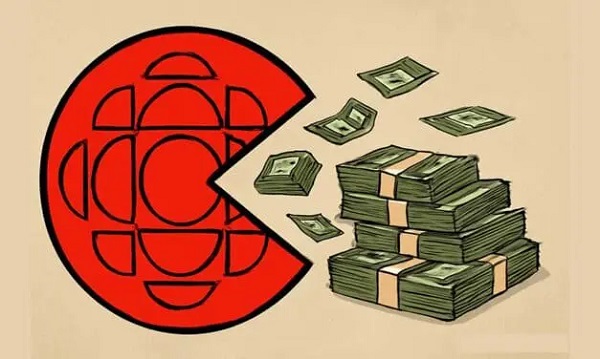
This article supplied by Troy Media.
 By Kris Sims
By Kris Sims
The CBC is draining taxpayer money while Canadians tune out. It’s time to stop funding a media giant that’s become a political pawn
The CBC is a taxpayer-funded failure, and it’s time to pull the plug. Yet during the election campaign, Prime Minister Mark Carney pledged to pump another $150 million into the broadcaster, even as the CBC was covering his campaign. That’s a blatant conflict of interest, and it underlines why government-funded journalism must end.
The CBC even reported on that announcement, running a headline calling itself “underfunded.” Think about that. Imagine being a CBC employee asking Carney questions at a campaign news conference, while knowing that if he wins, your employer gets a bigger cheque. Meanwhile, Conservative Leader Pierre Poilievre has pledged to defund the CBC. The broadcaster is literally covering a story that determines its future funding—and pretending there’s no conflict.
This kind of entanglement isn’t journalism. It’s political theatre. When reporters’ paycheques depend on who wins the election, public trust is shattered.
And the rot goes even deeper. In the Throne Speech, the Carney government vowed to “protect the institutions that bring these cultures and this identity to the world, like CBC/RadioCanada.” Before the election, a federal report recommended nearly doubling the CBC’s annual funding. Former heritage minister Pascale St-Onge said Canada should match the G7 average of $62 per person per year—a move that would balloon the CBC’s budget to $2.5 billion annually. That would nearly double the CBC’s current public funding, which already exceeds $1.2 billion per year.
To put that in perspective, $2.5 billion could cover the annual grocery bill for more than 150,000 Canadian families. But Ottawa wants to shovel more cash at an organization most Canadians don’t even watch.
St-Onge also proposed expanding the CBC’s mandate to “fight disinformation,” suggesting it should play a formal role in “helping the Canadian population understand fact-based information.” The federal government says this is about countering false or misleading information online—so-called “disinformation.” But the Carney platform took it further, pledging to “fully equip” the CBC to combat disinformation so Canadians “have a news source
they know they can trust.”
That raises troubling questions. Will the CBC become an official state fact-checker? Who decides what qualifies as “disinformation”? This isn’t about journalism anymore—it’s about control.
Meanwhile, accountability is nonexistent. Despite years of public backlash over lavish executive compensation, the CBC hasn’t cleaned up its act. Former CEO Catherine Tait earned nearly half a million dollars annually. Her successor, Marie Philippe Bouchard, will rake in up to $562,700. Bonuses were scrapped after criticism—but base salaries were quietly hiked instead. Canadians struggling with inflation and rising costs are footing the bill for bloated executive pay at a broadcaster few of them even watch.
The CBC’s flagship English-language prime-time news show draws just 1.8 per cent of available viewers. That means more than 98 per cent of TV-viewing Canadians are tuning out. The public isn’t buying what the CBC is selling—but they’re being forced to pay for it anyway.
Government-funded journalism is a conflict of interest by design. The CBC is expensive, unpopular, and unaccountable. It doesn’t need more money. It needs to stand on its own—or not at all.
Kris Sims is the Alberta Director for the Canadian Taxpayers Federation
Troy Media empowers Canadian community news outlets by providing independent, insightful analysis and commentary. Our mission is to support local media in helping Canadians stay informed and engaged by delivering reliable content that strengthens community connections and deepens understanding across the country.
Business
Trump family announces Trump Mobile: Made in America, for America

 MxM News
MxM News
Quick Hit:
On the 10-year anniversary of Donald Trump’s iconic campaign launch, the Trump family announced the debut of Trump Mobile, a new wireless company offering American-built smartphones, 5G coverage, and a values-driven alternative to Big Tech carriers.
Key Details:
-
Donald Trump Jr. and Eric Trump introduced Trump Mobile’s flagship service Monday, calling it a “transformational” alternative aimed at “our nation’s hardest-working people.”
-
The “47 Plan,” priced at $47.45/month, offers unlimited talk, text, and data, free international calls to U.S. military families, telehealth, roadside assistance, and no credit checks.
-
Trump Mobile’s customer support is fully U.S.-based and live 24/7—“not automated,” the company says—while a new American-made “T1 Phone” is slated for release in August.
Diving Deeper:
Marking ten years since President Donald Trump descended the golden escalator to launch his first campaign, the Trump Organization on Monday announced its boldest private sector move yet: Trump Mobile.
Flanked by company executives, Donald Trump Jr. and Eric Trump unveiled the new cellular service, touting it as a patriotic, people-first alternative to legacy providers. “We’re building on the movement to put America first,” Trump Jr. said in a statement. “We will deliver the highest levels of quality and service.”
The cornerstone of Trump Mobile is the 47 Plan. Offered for $47.45/month, the plan includes unlimited data, full 5G coverage across all three major carriers, and a suite of benefits tailored to middle-class families, truckers, veterans, and anyone tired of paying premiums to companies that don’t share their values.
Among the key perks: 24/7 American-based customer service (with “real people,” not bots), comprehensive device protection, roadside assistance through Drive America, and telehealth services including mental health support and prescription delivery. Most notably, the plan includes free international calling to over 100 countries—an effort the Trump family says honors U.S. military families stationed abroad.
“We’re especially proud to offer free long-distance calling to our military members and their families,” said Eric Trump. “Those serving overseas should always be able to stay connected to the people they love back home.”
Unlike traditional providers, Trump Mobile advertises no contracts and no credit checks, appealing to a demographic long underserved by mainstream telecom giants. “Hard-working Americans deserve a wireless service that’s affordable, reflects their values, and delivers reliable quality they can count on,” Eric Trump added.
The company is also preparing to launch the T1 Phone in August—a sleek, gold smartphone “engineered for performance” and “proudly designed and built in the United States.” With that, the Trump Organization is not just entering the mobile market—it’s staking a claim as a direct competitor to Apple and Samsung.
-

 Health21 hours ago
Health21 hours agoLast day and last chance to win this dream home! Support the 2025 Red Deer Hospital Lottery before midnight!
-

 Business2 days ago
Business2 days agoCarney’s European pivot could quietly reshape Canada’s sovereignty
-

 Alberta2 days ago
Alberta2 days agoAlberta’s grand bargain with Canada includes a new pipeline to Prince Rupert
-

 conflict1 day ago
conflict1 day ago“Evacuate”: Netanyahu Warns Tehran as Israel Expands Strikes on Iran’s Military Command
-

 Aristotle Foundation24 hours ago
Aristotle Foundation24 hours agoThe Canadian Medical Association’s inexplicable stance on pediatric gender medicine
-

 Energy1 day ago
Energy1 day agoCould the G7 Summit in Alberta be a historic moment for Canadian energy?
-

 Crime1 day ago
Crime1 day agoMinnesota shooter arrested after 48-hour manhunt
-

 Bruce Dowbiggin1 day ago
Bruce Dowbiggin1 day agoWOKE NBA Stars Seems Natural For CDN Advertisers. Why Won’t They Bite?


